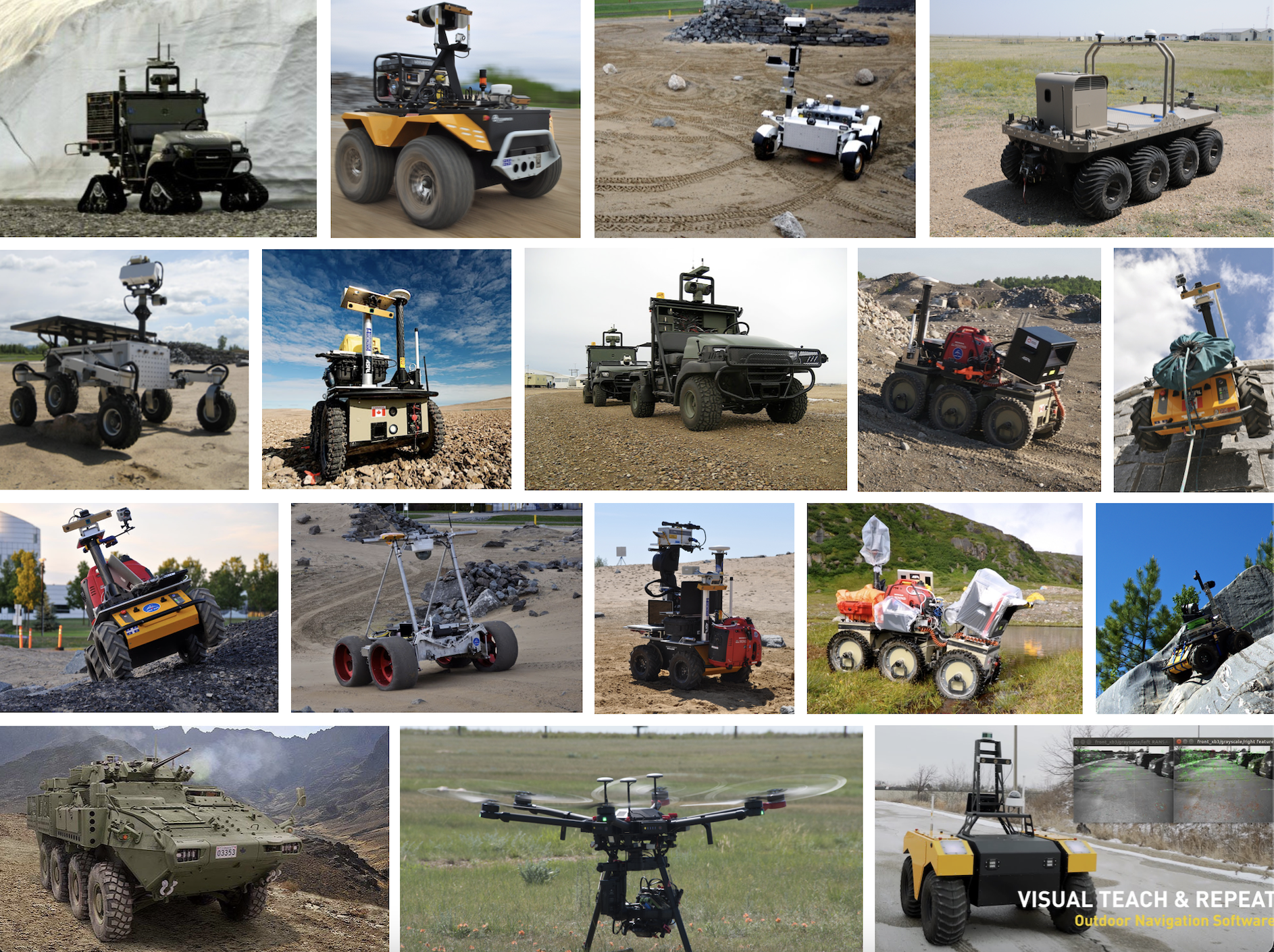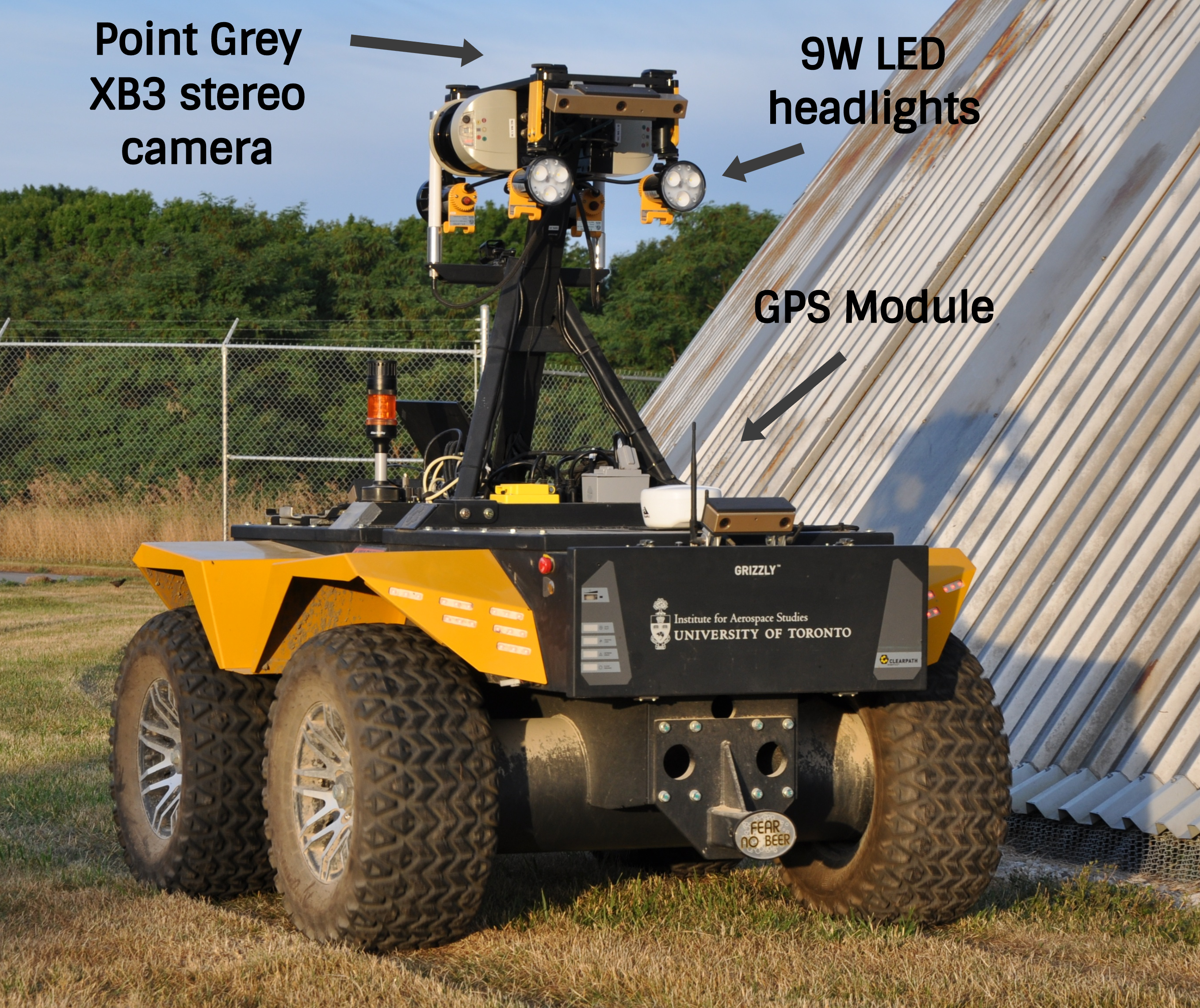Visual Teach & Repeat 3
This is the website for the Visual Teach and Repeat 3 (VT&R3) package, which is the C++ implemenation of the Visual Teach and Repeat system for robot navigation with a camera or LiDAR sensor. The package is developed and maintained by the Autonomous Space Robotics Lab (ASRL) at the University of Toronto Institute for Aerospace Studies (UTIAS).
Description
Visual Teach and Repeat (VT&R) is a navigation system for mobile robots. In the teach phase, a user drives the robot manually to teach a path, while the system builds a map. Afterwards, during the repeat phase, the map is used for localization as the robot follows the path autonomously. VT&R relies on local submaps only, which facilitates repetition of long paths without the need for accurate global reconstruction.
VT&R handles long-term navigation with the use of multi-experience localization. Each time the robot repeats a path, data from this new experience is stored in the spatio-temporal pose graph. Previously collected experiences can then be used to bridge the appearance gap for localization to the map as the environment changes.
VT&R3 is a C++ implementation of Visual Teach and Repeat. It is designed for easy adaptation to various robots and sensors, such as camera, LiDAR, RaDAR, or GPS. The current implementation includes a feature-based pipeline that uses a stereo camera, as well as a point-cloud-based pipeline for LiDAR sensors. More detailed description of VT&R3 can be found in this wiki page.
Hardware Requirements
To run VT&R3, you will need the following hardware:
- A ROS enabled robot platform. VT&R3 has been thoroughly tested on the Clearpath Grizzly robot.
- A NVIDIA GPU-enabled machine that can run Ubuntu 20.04. We have tested on the following laptop models:
You would also need the following stereo camera or spinning LiDAR.
- Bumblebee XB3 Stereo Camera
- LiDAR: Waymo Honeycomb, Velogyne Alpha Prime.
For more information, please refer to the Installation Guide under Hardware Recommendation. We are actively working towards enabling supports for more sensors. More info on that will be updated on this wiki page.
Installation
Please follow the Installation Guide to install VT&R3 and its dependencies.
Demonstration for Online VT&R3
Please see the following tutorial on how to run VT&R3 online on Grizzly robot. This tutorial gives basic info on how to use the UI to teach and repeat a path. More info on how to launch VT&R3 can be found on this Wiki page. (insert Jordy’s video here)
Extension Plan
Below is a list of features that we are currently working on. If you have encountered any other issues while running VT&R3, feel free to create a new issue on our GitHub page. If you have any specific feature request, please directly contact us at vtr@robotics.utias.utoronto.ca.
Path-Tracker Overhaul
In recent testing we have noticed some sub-optimal path tracking behavior under niche conditions. We will not be addressing these individual bugs immediately as in the near future we will be re-writing the current path tracker to implement constrained model predictive control associated with upcoming research.
RaDAR VT&R
We are working on enabling RaDAR-based localization in VT&R in the upcoming release.
Support for ZED Stereo Camera
We are currently working towards enabling support for ZED stereo camera in our VT&R framework. More detailed instructions on how to set up ZED camera and other sensors will be added to this wiki page.
Gallery of Robots that Use VT&R
Below are all the robots that use our framework.

Related Work
[1] Furgale P T and Barfoot T D. “Visual Teach and Repeat for Long-Range Rover Autonomy”. Journal of Field Robotics, special issue on “Visual mapping and navigation outdoors”, 27(5):534–560, 2010. doi: 10.1002/rob.20342, (google). (pdf), (video1), (video2), (video3)
@article{Furgale2010VisualTA,
title={Visual teach and repeat for long-range rover autonomy},
author={P. Furgale and T. Barfoot},
journal={J. Field Robotics},
year={2010},
volume={27},
pages={534-560}
}
[2] Paton M, MacTavish K A, Warren M, and Barfoot T D. “Bridging the Appearance Gap: Multi-Experience Localization for Long-Term Visual Teach and Repeat”. In Proceedings of the IEEE/RSJ International Conference on Intelligent Robots and Systems (IROS), pages 1918–1925. Daejeon, Korea, 9-14 October 2016. doi: 10.1109/IROS.2016.7759303, (google)
@article{Paton2016BridgingTA,
title={Bridging the appearance gap: Multi-experience localization for long-term visual teach and repeat},
author={M. Paton and K. MacTavish and M. Warren and T. Barfoot},
journal={2016 IEEE/RSJ International Conference on Intelligent Robots and Systems (IROS)},
year={2016},
pages={1918-1925}
}
